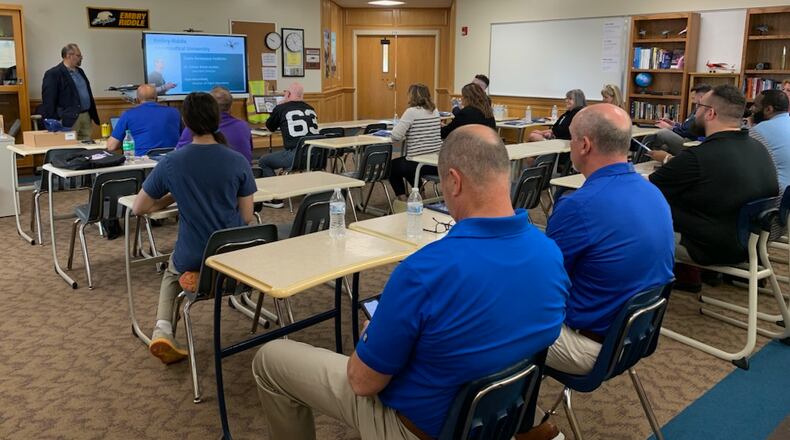The school has partnered with the GAI at Embry‐Riddle in Daytona Beach, Fla. since 2018 to offer high school level aviation courses that teach students about unmanned systems, including those related to aviation such as drones. The program has expanded to include Springfield-Clark Career Technology Center (CTC), Global Impact STEM Academy (GISA), Northwestern High School and Midview High School in Grafton near Cleveland.
The program is for anyone that wants to do anything aviation related, and it doesn’t have to be flying, said Shadh Molla, professor of Emmanuel Christian’s Aerospace Institute.
“(There are) all kinds of fields available and they (GAI) have good programs, even if you’re not going directly into aviation,” Molla said. “We’re really excited to be partnered with such a top-quality school. One of things I always tell parents, it’s the Harvard of aviation.”
Walsh-Conklin said it’s not about having a student go to Embry-Riddle but more about “feeding the industry.”
“When you go and you get on a flight, how many of you in the last year have flown and your flights been delayed? It’s not weather. It’s crew, it’s pilots, it’s mechanics. They don’t have them,” she said.
Walsh-Conklin, along with Dave Moorefield, director of flight operations, said there’s about 750,000 pilots, 780,000 maintainers, 760,000 engineers and 800,000 crew member job openings in aviation that are needed.
Credit: Bill Lackey
Credit: Bill Lackey
“You’re talking 2.5 million people,” Moorefield said, stating this doesn’t even include the Advanced Air Mobility sector.
“That’s going to be a future need in those number that aren’t even calculated yet,” Walsh-Conklin said. “So it’s going to take way more than a handful of universities to meet that need.”
Molla held a meeting earlier this month to give an update on the program to almost 25 people including officials from Emmanuel Christian, Embry-Riddle, Unmanned Safety Institute (USI), Clark State, Cliff Park High School, Logan High School and State Rep. Bernie Willis, R-Springfield.
The program is funded by the Ohio Department of Higher Education (ODHE). The total allocation for fiscal years 2024 and 2025 is $250,000 each, as well as $25,000 reserved for new schools and $36,000 a fiscal year per member school.
“What that means is we have set aside for new schools that are interested and want to get started right now, we have money set aside to accommodate that, (but) we’ll be looking for more funding as we move forward,” Molla said.
Molla said the funds for member schools includes equipment, sending people for training, enrichment programs like field trips to the Air Force Museum, and activities related to the program.
For the 2026 grant proposal, Molla wants to expand the funding to include all general aviation and all schools in Ohio.
Willis was instrumental in spearheading the expansion of the Florida program into Ohio, Molla said, in which he dedicated the school’s aviation library to during the meeting.
When Willis became a teacher, he said he reached out to a friend in Florida about them looking to get into STEM and that’s when he learned the program in Florida was looking to expand into other states. He then talked to his then state representatives and senator who “were so excited and wanted to try to get something into a state budget to get a pilot program.”
“We were about four months too late to get into that budget cycle, but they said if you can get it started anyway, and we did. We went to a local foundation, got some money to put together to get the first year done ... and it just took off,” Willis said. “What we found out was this was something that not only we wanted but the kids were highly desirable of and people in the local area wanted also.”
Willis said after they got the program started, COVID hit and caused it to be delayed. Now it’s a pilot program in the statewide budget and got doubled this last year because of the schools that have been added.
“COVID (hit), so we were sitting here probably two or three years delayed where we would have been I think with this program. Because COVID not only shut down what we were doing to the education system, but everybody did what they could to keep teaching kids, getting things done, but it stopped us from pretty much starting any new programs anywhere,” he said.
This program started for unmanned aviation without knowing how quickly Advanced Air Mobility was going to “come at them,” Willis said.
“So because we’re the home of aviation, because all these things are falling into place at the same time, we’re going to continue to spend and invest in this field because we know all the demand is there, we are not going to be able to catch up with it fast enough, but we are going to do the best job we can do,” he said.
Willis also recently had legislation that was approved by the Ohio House to establish state laws for the operation of drones, and it now goes to the Senate for further consideration.
The legislation will codify the current federal FAA laws and create four prohibited flying areas or operations as state law, including operating a drone: in a reckless manner that endangers other, in a way that is prohibited by FAA regulations, that interferes with first responder activities, and to a record or loiter over or near a critical infrastructure. It will also give local government control to further restrict operation of recreational drones in or above a park or other public property owned by the local government and will task the Ohio Department of Transportation Office of Aviation to publish all regulations relating to drone activity in the state.
“Ohio has to establish laws to ensure that we have the ability to prosecute bad actors with drones. Currently, Ohio prosecutors have to find a US Attorney to prosecute those who violate the Federal Aviation Regulations whenever they fly over a football game without permission and in a no-fly area,” Willis said. “This is the first step to getting Ohio on track to preserve the public trust in these unmanned aerial vehicles in the airspace over Ohio.”
In the program, students earn course credits between 8 and 16 hours related to aviation, including drones, and study and prepare for the FAA Part 107 test to get a pilot’s license to be certified to fly unmanned drones. Some of the courses include Journey to Flight, an introduction to aviation history aeronautics, general aviation and UAS; Principals of Aeronautical Science, a survey of aviation topics such as aerodynamics, airframes, meteorology, navigation, flight physiology, aviation industry, and regulations; and Unmanned Aircraft Systems, a survey of UAS, with an emphasis on operations.
The program currently has 114 students with 258 credits earned. The projected enrollment for the 2024-25 school year is 208 students, which is a 94 student increase in one school year.
The program has had a big impact on students including them using drones for real world assessments of school traffic patterns, sitting for FFA flight tests, starting a business taking aerial photos for real estate companies, flying drones for a local agricultural company, and flying Apache helicopters for the U.S. Army.
Many industries are adapting to drones such as real estate, agriculture, mining, gas and electric, construction, film, public safety, law enforcement, insurance, journalism, transportation, telecommunications, meteorology and retail.
Molla said the projections for expansion of the drone business and for the jobs that come with that are slated to grow about 13% every year, which is about 75,000 to 150,000 new jobs over the next 10 years. The median salary is $85,000, with a range of $50,000 to $200,000.
The main challenges of the airline industry are because of the lack of qualified personnel including pilots, maintenance crews and others, Molla said, and the STEM programs are not keeping pace with the demand for new aerospace talent.
He said two thirds of aerospace companies expect workforce issues in the next 3-5 years, and 25% of those expect to lose revenue as a result, which doesn’t include the 29% of the aerospace industry workforce that will retired in the next 10 to 20 years.
“So we’ve got the demand that’s growing and the workforce that’s shrinking. That gap, this is an opportunity. This is where we can come in and fill that opportunity,” Molla said.
As for the future, Molla said the “big picture” goals for program are to use it as an avenue for entry into the UAS industry, the aviation industry, prepare students to be competitive for positions and expand the program to new schools.
About the Author




